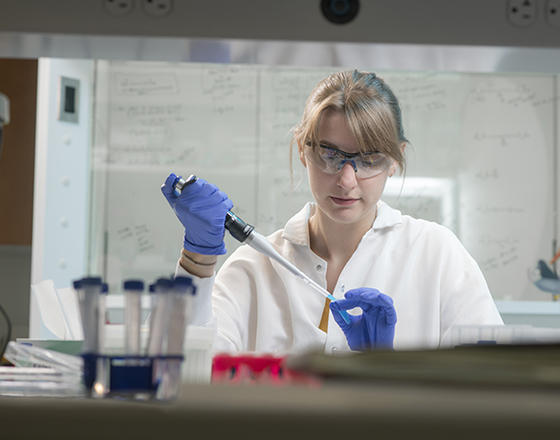In This Story
Bioengineers—like Remi Veneziano—find solutions to some of the world’s grand problems. But sometimes, it takes collaboration with scientists to find out the questions that need to be answered to properly apply and maximize these engineering solutions.
Veneziano, an assistant professor in the College of Engineering and Computing, is partnering with Amanda Haymond, a research assistant professor in the School of Systems Biology, to apply DNA nanotechnology to create a drug that boosts the immune response to fight breast cancer.

Their work entitled “New Hybrid Molecular Modalities Comprised of DNA-Origami and Interfering Peptides as Inhibitors of Protein-Protein Interactions” received a grant of nearly $530,000 from the National Institutes of Health’s Innovative Molecular Analysis Technologies program, which funds explicitly creative technologies for cancer detection or treatment. “There are two big things we are trying to do with this work, one is to answer a biological question, and the other is to provide a proof of concept for a new drug modality,” says Haymond.
On the biology side, Veneziano and Haymond are looking to target a specific protein’s complex. When a body is infected with cancer, a protein called IL-33 will signal the immune system to flood the cancerous area with immune cells to combat cancer and stop further damage. “However, in a chronic inflammatory cancer context, the flood of IL-33 can recruit a number of other cell types, including MDSCs, that are activated by binding to IL-33 and tamp down on the immune response,” says Haymond.
The influx of suppressive immune cells can be detrimental as the body stops fighting the cancer. In addition, the protein structure created from the interaction of IL-33 and MDSCs is quite large, which makes it difficult to target with conventional small molecule drugs. This is where Veneziano’s work in DNA nanotechnology comes in.
“With the technology we are developing, instead of testing multiple drug combinations for efficiency, we can take into consideration the structural parameters of the protein we are trying to target, and use DNA nanotechnology to build rigid nanoscale objects that would have the same dimensions and organization as the protein to target multiple sites of the protein simultaneously,” says Veneziano.

Therefore, the drugs they are developing will act as adaptors that will prevent the proteins from interacting together. Veneziano’s nanotechnology research makes it possible to precisely target multiple sites on these proteins concurrently to increase the success of their drug. So, instead of using three separate drugs that possibly won’t work in tandem properly to prevent this immune response, Haymond and Veneziano are developing a new drug modality that is exactly designed with the target in mind.
Veneziano is hopeful that this process could be completely automated, making it easier to target certain proteins to combat different types of cancer and diseases. This expansion will require even more collaboration between scientists and engineers in the future, Haymond and Veneziano say.
“This work can’t be done by bioengineers or biologists independently. It takes synergy between the two of us, and Mason and its institutes promote these types of collaborations,” says Veneziano.
